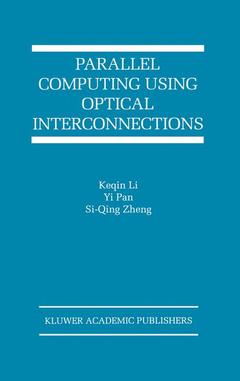Parallel Computing Using Optical Interconnections, Softcover reprint of the original 1st ed. 1998 The Springer International Series in Engineering and Computer Science Series, Vol. 468
Langue : Anglais
Coordonnateurs : Keqin Li , Yi Pan , Si-Qing Zheng

Advances in optical technologies have made it possible to implement optical interconnections in future massively parallel processing systems. Photons are non-charged particles, and do not naturally interact. Consequently, there are many desirable characteristics of optical interconnects, e.g. high speed (speed of light), increased fanout, high bandwidth, high reliability, longer interconnection lengths, low power requirements, and immunity to EMI with reduced crosstalk. Optics can utilize free-space interconnects as well as guided wave technology, neither of which has the problems of VLSI technology mentioned above. Optical interconnections can be built at various levels, providing chip-to-chip, module-to-module, board-to-board, and node-to-node communications.
Massively parallel processing using optical interconnections poses new challenges; new system configurations need to be designed, scheduling and data communication schemes based on new resource metrics need to be investigated, algorithms for a wide variety of applications need to be developed under the novel computation models that optical interconnections permit, and so on.
Parallel Computing Using Optical Interconnections is a collection of survey articles written by leading and active scientists in the area of parallel computing using optical interconnections. This is the first book which provides current and comprehensive coverage of the field, reflects the state of the art from high-level architecture design and algorithmic points of view, and points out directions for further research and development.
Massively parallel processing using optical interconnections poses new challenges; new system configurations need to be designed, scheduling and data communication schemes based on new resource metrics need to be investigated, algorithms for a wide variety of applications need to be developed under the novel computation models that optical interconnections permit, and so on.
Parallel Computing Using Optical Interconnections is a collection of survey articles written by leading and active scientists in the area of parallel computing using optical interconnections. This is the first book which provides current and comprehensive coverage of the field, reflects the state of the art from high-level architecture design and algorithmic points of view, and points out directions for further research and development.
Optical Interconnection Networks and System Architectures.- Lightning Network and Systems Architecture.- Parallel Computing with “Intelligent Optical Networks”.- Scalable Optical Interconnection Networks for Large-Scale Parallel Computers.- The Communication Capabilities of Partitioned Optical Passive Stars Networks.- Otis Optoelectronic Computers.- On Wavelength Assignment in WDM Optical Networks.- Models and Algorithms for Optical Interconnections.- An Abstract Model for Optical Interconnection Networks.- A Unique Design of Fiber-Optic Interconnection Networks and Algorithms.- Fundamental Algorithms for the Array with Reconfigurable Optical Buses.- Computing the Hough Transform on Arrays with Reconfigurable Optical Buses.- Basic Data Movement Operations on the LARPBS Model.- Fast Matrix Multiplication and Related Operations Using Reconfigurable Optical Buses.
Date de parution : 03-2013
Ouvrage de 280 p.
15.5x23.5 cm
Thème de Parallel Computing Using Optical Interconnections :
Mots-clés :
Processing; Scala; Scheduling; VLSI; algorithms; communication; development; requirements
© 2024 LAVOISIER S.A.S.


